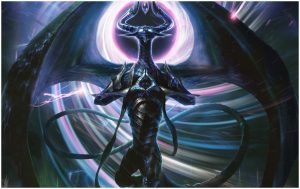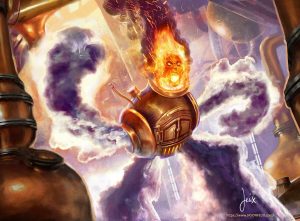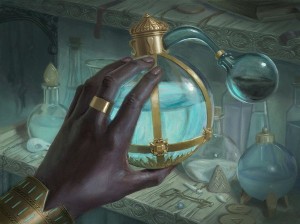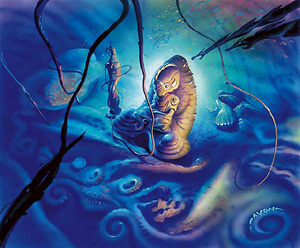Are you a Quiet Speculation member?
If not, now is a perfect time to join up! Our powerful tools, breaking-news analysis, and exclusive Discord channel will make sure you stay up to date and ahead of the curve.
We've reached the end, folks! All five parts of the round table discussion are available here. Part 5 is available down below.
The rapid-fire rate of release of Magic product in the last few months has been absolutely staggering. With all of these releases so close together, it feels like we've been on the ride for several months, without much chance to stop.
Our staff here at Quiet Speculation felt it was appropriate to come together as a team and discuss the implications of this release schedule, and why they matter. Welcome to our first round table discussion, focusing on the last three months of product releases.

1. Are there too many releases to keep up with?
Chaz Volpe: Not at all. There’s a product for all players currently - some may not pertain to you - and that’s okay. It’s in the game’s best interest to keep providing us with releases and/or content to help stay relevant.
Chris Martin: WotC tested the boundaries of wallet fatigue and sensory overload with a hat trick of releases, but I didn't find it to be too many. It is great for players because the possibilities feel endless and it is equally great for content creators because of the freshness it injects into their work.
David Schumann: Maybe not now, but a constant barrage of new products will lead to "excitement fatigue", where each subsequent set will feel less special/unique. There would likely be wallet fatigue as well, one reason we often look for good speculation targets from Standard legal sets released shortly before masters/specialty sets is that players have limited financial resources and they utilize them to maximize their enjoyment, which often means they reduce purchasing of one product in favor of the next.
Niels Rietkerk: As someone who has not dealt in recent cards for over a decade it doesn’t matter much to me, however, it does feel like we’re getting a lot of releases in a short time frame. I fear wallet fatigue among players. If less is bought per set, because the money gets spread out more, it may also lead to cards from less popular sets becoming rarer.
Kelly Reid: No, I love the frequency of releases. They should print more Magic cards in general. Collectibility is for Reserved List cards and variants like promos. Magic cards should be cheap enough that people buy lots of them and trade them often. That's what's best for the game. As a casual player, a lot of the non-tournament cards end up being amazing in my various playgroups, even if they're just quirky trick cards; those end up in my Danger Room stack. I think they're in a good groove now and hope they keep it up. They have a license to print money with MTG and I think they should use it to the fullest.
Tarkan Dospil: My short answer to these types of questions is always - "Despite what many may think; Wizards knows what they're doing." From my perspective, wallet fatigue certainly seems like a thing, but they have teams of experts analyzing market data to determine how the consumer base will ingest the product. I will stress that WotC is NOT interested in burning out consumer wallets for short-term gain. There are too many hands in the pie from Hasbro down, and the brand is too valuable. They may make mistakes along the way, but they have zero incentive to drive the game into the ground by burning buyers out. From a secondary market perspective, an increase in the release cadence means a lot of things will be undervalued, simply because they're left behind. This leaves room for a lot of opportunity. It also allows for many new card interactions to emerge sooner, which keeps the market interesting.
Sigmund Ausfresser: The issue isn't necessarily about keeping up - the QS Insider Discord does a great job staying on top of spoilers - but having sufficient resources to fully appreciate each set. If each new set brings cards that would fit into your decks, and you want to draft each one a couple of times, and you want to speculate here and there, you run out of cash very quickly. I don't see how these rapid-fire set releases aren't cannibalizing each other, both from a sales and overall excitement standpoint.
Christopher O'Berry: The release schedule this year has been rapid, and I'm definitely feeling the strain of it all. The fatigue is real. That being said, the release schedule has brought a lot of hype for the game overall, and I believe that will be a good thing for Magic in the long run. Design and play experiences for these recent sets have overall been very good, and if they continue to churn out products of this quality at an even rate, I don't foresee them changing course any time soon.
Kyle Rusciano: No. After throwing more and more product releases at Magic players year after year for the past several years, Wizards' decision to pull back in 2019 shows that they now know and respect the number of releases beyond which the market sinks into fatigue and disinterest. Players want to feel that they can keep abreast of what is going on in Magic, and they can do that more easily this year. In 2017 and 2018 there were definitely too many sets; the market was clearly oversaturated and uneasy about the ever-increasing frequency of supplemental sets filled with reprints. In 2019, however, there will be one or two fewer supplemental sets, which will make for a far more digestible number of releases. What I question is the timing of these releases. It's important to let each set breathe and space them out relatively evenly.

2. Should the timeframe for spoiler season be changed?
Reid: They should just release the whole set at once. There's no real suspense or drama these days; they should just show us the whole edition as a complete thought. Don't pretend to tease us. I also think the drip-release can cause subconscious biases due to recency and primacy effects. Players may over-rate the first big mythic rares they see, and under-rate subsequent ones. Finally, you eliminate the 'dead-brew' time when you've seen some cards and you want to build decks, but have to wait till they're all released. This is a boring and frustrating time to be a Magic player.
Dospil: I thought the experiment with War of the Spark; whereby they protracted the spoilers by an entire month to tell the WAR story, was a fantastic play. It added another layer to the spoiler experience, and allowed time for the market to group-think how the cards may impact the game. I want to stress that second part: Spoilers aren't just to reveal cards, anymore. In my view, they're part of the broader engagement strategy that WotC seems to be employing, where you're interacting with the game at all times across a variety of vectors (spoilers, social media, content creators, FNM, etc). I like the extended spoiler methodology like WAR, and I hope we see more of that in the future.
Ausfresser: The current spoiler season pacing is fine. Spoiling cards over the course of two weeks feels like an appropriate rate, though I'm not sure how exciting all these common and uncommon spoilers are. The issue is when one spoiler season is right up against another, and before you even get the new cards in your hand, you have to think about the next set.
O'Berry: At current, I think it's just right. My main issue with the current hype cycle formula of these last three sets was not enough time in between them, and not necessarily for the spoiler season itself. That being said, I think the style in which the spoilers are doled out needs a little innovation. War of the Spark was a fantastic example of how to build hype by carefully curating the spoiler schedule according to the story. This won't work for every set, I imagine, but there is definitely creative space for spoiler releases that have yet to be explored.
Rusciano: No, two weeks for supplemental sets and between two to three weeks for normal sets is fine. This is especially true if we get to experience the main storyline as a part of spoiler season as we did with War of the Spark; I found myself caring more about the story in part due to the way that spoilers followed the set's narrative arc. Hopefully, we will experience more of this going forward.
Volpe: The time-frame for when previews are provided, should be changed. It would certainly be hard to accommodate all players and many time-zones, but there has to be a more efficient way. With more players tapped into the many facets of the game, especially the financial facet-information is the most valuable commodity. Missing major new previews of cards or product is not a great feeling just because you have other commitments in your day.
Martin: I would prefer a quicker spoiler season and a consistent place to find the cards the moment they are spoiled (ex: when someone is scheduled to spoil a card that card should be posted at that same time to a Wizards spoiler homepage). I think the current format of spoilers being done by MTG personalities is too fractured and causes inadequate delivery of information.
Schumann: I don't see any solid argument to change the timeframe. As stated above my bigger concern is the various fatigues that go with a constant barrage of new product options. I would prefer it if they released the spoilers in a more organized/controlled fashion, something like 1 mythic/4 rares/4 uncommons/5 commons a day or something more set so we would know when we could “turn off” for the day and not worry about missing out.
Rietkerk: I believe longer would be better, but only if there’s enough time between sets. With the increasing release frequency, a shorter timeframe would probably be more appropriate just to make sure there’s no overlap.

3. Is the high volume releases healthy for the secondary market?
Dospil: I don’t think it’s unhealthy. Look at historical data of MTG releases and you'll see that the product is incredibly resilient. Almost no set falls into 'worthlessness' and nearly all sealed product sees growth over time. To reiterate my point from question one - more product means more cards are left behind, only to creep up in value over time as new competitive interactions are discovered and/or the casual market finds cool things to do with them.
Ausfresser: This is a complex question, and it depends on your definition of "healthy". I don't see any systemic risk to the high volume of releases. Long term, some cards in these sets may have a higher secondary market value simply because not enough product was opened during these back-to-back set releases. This will create opportunities to profit as these cards age, and that is interesting for me to track. But some may not deem this as healthy.
Rusciano: Reprints, not new card printings, are bigger drivers of market unease and panic than new card printings. The market was clearly displeased at the rate of reprints flooding the market once Wizards began releasing multiple Masters set per year. It's no accident that the secondary market is far happier and healthier this year now that Wizards has taken its foot off the gas pedal. As long as Wizards has only one major reprint set a year (counting something like Modern Horizons as half a reprint set), the market will be healthy and happy. In general, I think it's good that Wizards creates sets that give us alternate ways to play, be it multiplayer (Conspiracy), 2-on-2 (Battlebond), or whatever else they think of next.
Volpe: Overall, yes - but, the issues with information and timing as I mentioned above is unhealthy on the market for a broad number of players. Other than that specific issue: More sets, more cards, more eyeballs, new interactions, MTG Arena - all of these aspects are now working in tandem to bring new players and visibility to the game. This is healthy, this is what we want as players of any type, as store owners, as fans of the game. More importantly, it elevates the value of the game.
Martin: In general, the high volume of new products causes longer tails on EDH spec maturity because player/brewer focus is distracted. It also causes an abnormal amount of speculator dollars entering the market which inflates a large portion of cards unnecessarily. That said, it is healthy for the secondary market so long as the products are well-received (i.e. Magic as a game is healthy then so will be the secondary market).
Schumann: Yes and no. Obviously, Chronicles wasn't and that is what caused the formation of the reserved list in the first place. Too limited of a print run can cause card prices to soar and alienate players. This is similar to how the original Modern Masters sold out everywhere and all the effort into developing a good limited format by the development team was pretty much wasted. Most people barely got to experience that limited format.
Rietkerk: Because I reckon the increased frequency may lead to some sets being undersold relative to others I would expect popular cards from those sets to reach greater heights. I am reminded of Voice of Resurgence back in Dragon’s Maze that reached great heights because the set was relatively unpopular.
Reid: For sure. If retailers buy it from WotC and players buy it from retailers, everyone wins. The more cards moving through the market, the better. There might be some dilution of value for higher dollar cards when they're reprinted, but this is not a major or frequent concern. Overall, more cards in hands means more people committed to the game of Magic, which creates and supports the secondary market.
O'Berry: If buyers are ready to shoulder the cost every other month to purchase new Magic product, then I don't see any reason to label this release schedule as unhealthy. I think the biggest challenge for buyers and sellers in the secondary market will be obtaining or moving cards at a rate that allows them to keep up with trends. You don't want to be stuck holding the bag on products that have no demand.

4. Do you think this hectic release schedule is sustainable for Wizards?
Ausfresser: It's possible. I assume Wizards has done extensive study on release schedules, pacing, and the like. They would be in a better position to evaluate its sustainability. If I had to guess, I'd say it is sustainable long-term, but they may evolve the kinds of sets they release over time. For example, perhaps a Commander-focused set, followed by a Standard set, followed by a Modern-focused set would be reasonable to release back-to-back because the target audiences are different. They won't likely accelerate the release schedule for Standard sets--that wouldn't be sustainable.
O'Berry: The release schedule of this first half of the year was incredibly quick, but the quality of these sets was equally as high. If WotC can continue to release products of this caliber, there will be enough demand to justify pushing out so many products in such a short timeframe. It's possible they'll find the upper limit of this as early as the end of the year, but it's too early to tell yet.
Volpe: This question could be covered in multiple articles- but my short answer is Yes; it’s sustainable. At least, I hope they can sustain this. In the larger gaming genre, many games currently suffer and atrophy due to an inconsistent release schedule of content. This can lead to a myriad of reactions, some justified, others not so much-but folks could leave the game entirely as a result. I don’t want to see that happen to this game. The more content, the better-especially in our present time.
Martin: The hectic release schedule isn't sustainable for WotC long-term if it cuts into the quality of set design. The proven model has always involved a creative product design with a strong limited format, so if more products in a cycle ends up hurting that formula WotC will have to readjust.
Schumann: No. Not only is player fatigue a problem (both wallet and excitement), but I’d imagine their development team would have difficulty sustaining this rapid-fire release schedule. I’d expect that in order to release sets rapidly the development time is reduced which likely means that we’d expect more bans and/or broken format warping cards to be released which is a detriment to the game.
Rusciano: Here is how I would reconfigure the release schedule to more evenly space them out. Since 2019 seems poised to be a year in which Wizards releases a judicious amount of product, I'll use it as an example:
January 15th: Ravnica Allegiance
March 1st: Gideon Spellbook
April 1st: War of the Spark
June 1st: Modern Horizons
July 15th: Core Set 2020
August 21st: Commander 2019
October 1st: Fall set (Codename: Archer)
November 21st: potential supplemental set
The biggest difference between Wizards' schedule and mine is that Wizards released War of the Spark about a month later than I would have and scrunched everything else together as a result. Another point of contention is the release of the winter set -- I wouldn't wait until the last weekend of January to release it. Releasing it in mid-January gives spring and summer releases an extra week or two to breathe.
Rietkerk: For newer players frequent new releases are exciting, it’s likely those who have been around longer who observe the increased release frequency and realize there is more they might want to buy in a given period. If Wizards is on a strategy of mostly catering to the newer players then this strategy may very well prove sustainable (with some grumbling from the enfranchised players).
Reid: Yes. We players can suck down information in firehose-like quantities and we're always thirsty for more. I say keep it coming until they find any good reason to pump the breaks.
Dospil: I think this relates to WotC attempting to adapt to a contemporary games market that is increasingly “here today, gone tomorrow”. They want MTG to always be in the back of players’ (and even non-players) minds. So long as core game design doesn’t suffer, I don’t see any problem with a continuous stream of releases, and I certainly do think the modern, attention-deprived gaming community can adjust. The most important key to this is WotC continues to expand awareness and recruit new players. Players are the lifeblood of the game, and the more we have, the easier all of this is.

5. What was the most important lesson to take away from these last three months of spoiler seasons?
Schumann: It’s easy to get swept into a wave of excitement and jump in on lots of different specs. While we do promote some diversification, too much is also a problem. It’s important to sometimes hold off and really evaluate an opportunity to determine if you really want to park money into it. Before buying into any spec I like to consider what price I think is a reasonable “out” and how much profit I’d make if the card did reach that price. I’d also have to factor in fees/shipping associated with outing said target and then determine what type of profit margin I’d make.
Rietkerk: My recommendation would be to try to identify which sets are less popular and identify the cards from those sets that are popular. Barring reprints, these should have the best future ahead of them as they should be showing what was known as the ‘third set phenomenon’ back in the day.
Volpe: Commander/EDH is currently the primary drive of the game-and source of hype and excitement for players. If it wasn’t known, or on the fence about that fact before; know it now. I’ve spent, and sold more in the last three months- between War of the Spark/Modern Horizons and now Core Set 2020, with Commander 2019 around the corner; than I have in some years, total. Even considering I don’t spend nearly as frequently as I have in the past.
Rusciano: With so many new releases, and releases that are geared for different audiences, it's important to write down (yes, write down) the time window during which you want to buy cards from a particular product and the time window during which you want to sell cards from a particular product. That's been a big takeaway for me. Speaking from a digital finance perspective, I'll say too that I've been holding my speculations for less time on MTGO. Churn is an important concept that I plan to emphasize more in my articles. In the past I would hold cards for 6-12 months; now I'm holding cards for 1-2 months. I only have 20% of my speculations from RNA season outstanding and only 40% of my speculations from the current WAR season outstanding.
Martin: The most important take away for me is to practice tremendous patience and pick your spots when speculating during a heavy volume of new product releases. Ignore edge cases and don't slip down a rabbit hole chasing specs; focus solely on the cards which will see the most immediate increase in demand.
Ausfresser: It's important to maintain steady cash flow. If you went all in during War of the Spark you would not have had sufficient resources to adequately buy into Modern Horizons and Core Set 2020. As cards spike, it's critical to sell into that hype to maintain that steady flow of cash and enable subsequent purchases. Even if you're bullish about the long-term prospects for a given card, you may be best served focusing on short-term opportunities during these rapid set releases, and then shift towards long-term holds only after the pacing slows down again.
O'Berry: If there's one thing I can take away from the three months, it's the fact that keeping your purchasing power relatively even across every release is important. I went in on a lot of specs during War of the Spark, and had to make quick moves in order to have the resources to invest in Modern Horizons, and now Core Set 2020.
Reid: Just. Chill. I get excited about new cards and I just want to play with them NOW, so I understand. But 95% of cards are worth a lot less after a month or two. If you can't wait a few weeks because you want to play Standard on Day 1, then wait until the cards are actually in players' hands. Trade for as much as you can, and buy the rest with cash. But there's no reason to jump at buying things when they're first put up for presale. None.
Dospil: The turn-n’-burn buy/sell strategy is more important now than it ever was. With no more dedicated reprint sets, cards will be reprinted anywhere and anytime. Predicting what will be reprinted where will be an incredibly difficult challenge, meaning it’s imperative to ‘lock in gains’ and move on from positions.
As has been stated by others: Casual is King. The Commander and Kitchen Table market is clearly the focus of the game and its design and has slowly taken over the secondary market (particularly in the US). Tournament staples still have flash, but they no longer determine how potent a set is or how successful it will be. I think a perfect example is Modern Horizons, a set with a small handful of relevant Modern cards…and a plethora of powerful casual cards.
Preorder speculation continues to die a slow death as a revenue stream. The collective MTG hivemind is simply too good at card evaluation these days, and more cards are launching at ‘correct’ preorder prices (which is to say, more preorder pricing leaves little room for hype to drive them further up). There are fewer and fewer targets that have a good entry point, and the scant few that do don’t often show the kinds of returns they used to.




